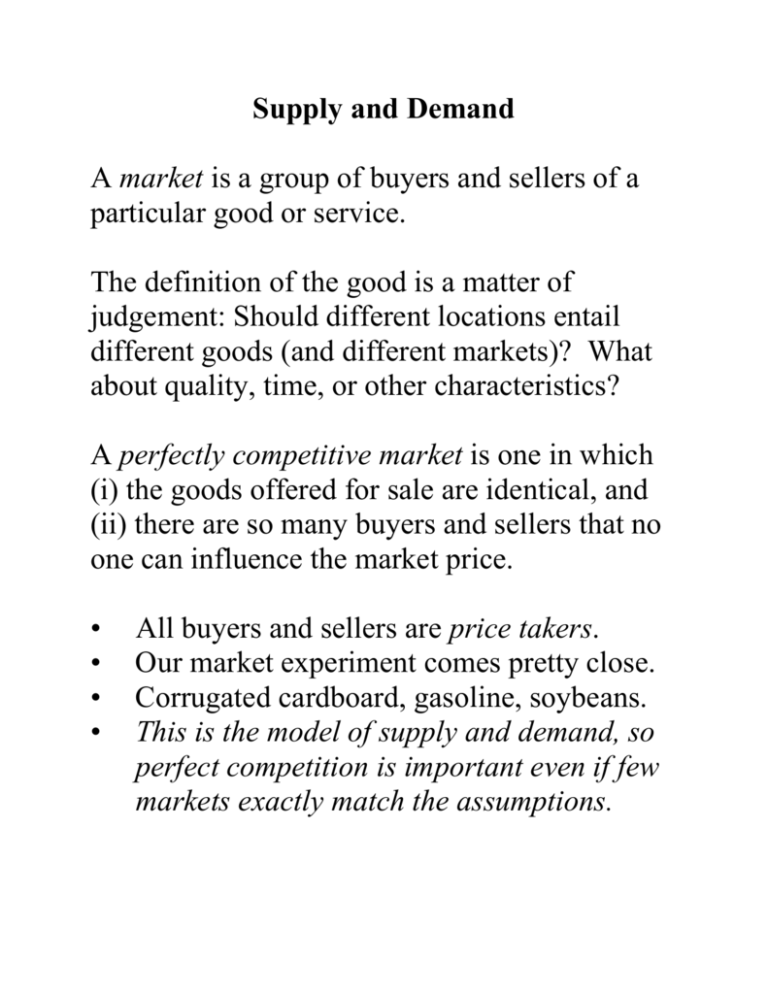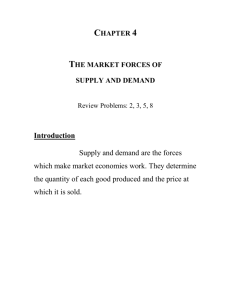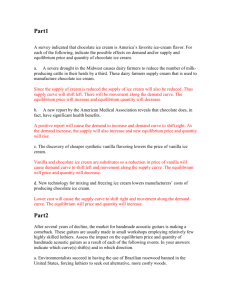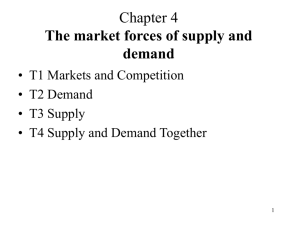Supply and Demand A market is a group of buyers and sellers of a
advertisement

Supply and Demand A market is a group of buyers and sellers of a particular good or service. The definition of the good is a matter of judgement: Should different locations entail different goods (and different markets)? What about quality, time, or other characteristics? A perfectly competitive market is one in which (i) the goods offered for sale are identical, and (ii) there are so many buyers and sellers that no one can influence the market price. • • • • All buyers and sellers are price takers. Our market experiment comes pretty close. Corrugated cardboard, gasoline, soybeans. This is the model of supply and demand, so perfect competition is important even if few markets exactly match the assumptions. Demand for Ice Cream The quantity demanded depends on: Price–the higher the price, the less you buy. Income–for normal goods, the higher your income, the more you buy. For inferior goods, the higher your income, the less you buy. Prices of related goods–frozen yogurt is a substitute for ice cream, so when its price goes up, more ice cream is demanded. Hot fudge is a complement for ice cream, so when its price goes up, less ice cream is demanded. Tastes–when tastes change, the quantity demanded changes. For example, our taste for ice cream might depend on the weather. Expectations–expectations about future income or prices affect the quantity demanded today. The demand schedule (a table) and the demand curve (a graph) show the relationship between the price of a good and quantity demanded of that good. Ceteris Paribus means “other things being equal”. All variables affecting demand other than price are assumed to be held fixed when we are talking about a particular demand curve. A change in the price changes the quantity demanded, so we move along the demand curve. A change in income, prices of other goods, etc. increases or decreases demand, so the demand curve shifts. The market demand curve is the sum of the demand curves of all the buyers. Horizontally add the quantities demanded at any price. Supply of Ice Cream The quantity supplied depends on: Price–the higher the price, the more firms want to supply. [sometimes called the Law of Supply] Input prices–less ice cream is supplied when workers must be paid more, ice cream machines cost more, or ingredients like cream and sugar become more expensive. Technology–the invention of better ice cream machines or an idea to make better use of counter space can lower a firm’s costs and raise the quantity of ice cream it supplies. Expectations–expectations about future prices of ice cream and inputs can affect the quantity supplied today. For example, if the price of ice cream will be higher tomorrow, you may want to sell less today and keep more in storage. The market supply curve is the sum of the supply curves of all the producers. Horizontally add the quantities supplied at any price. When input prices, technology, or expectations change, this causes a shift in the supply curve. For example, an increase in wages causes a decrease in the supply of ice cream (shift), while a drop in the price of ice cream causes a decrease in the quantity of ice cream supplied (movement along the curve). Equilibrium An equilibrium is a situation where demand and supply are in balance. The price at which the demand and supply curves intersect is the equilibrium price, and the quantity at which they intersect is the equilibrium quantity. At the equilibrium price, buyers can buy all that they want and sellers can sell all that they want. In this sense, we have market clearing. If markets are temporarily out of equilibrium, then the forces of supply and demand will adjust to move us back towards equilibrium. To analyze an event that affects the equilibrium in a market (like a heat wave), you must 1. Determine whether the event shifts the demand curve, the supply curve, or both, 2. Determine whether the curve shifts to the left or the right, 3. Use a demand and supply diagram to compare the original equilibrium with the new equilibrium. Finding an equilibrium using algebra Suppose the equation for the demand curve is QD = 1000 - 20 p and the equation for the supply curve is QS = 30p What will be the equilibrium price and quantity? Setting the quantity demanded equal to the quantity supplied, we can solve for the equilibrium price: 1000 - 20 p = 30 p, so p = 20. To find the equilibrium quantity, substitute p = 20 into the demand or supply equation, QD = QS = 600.








